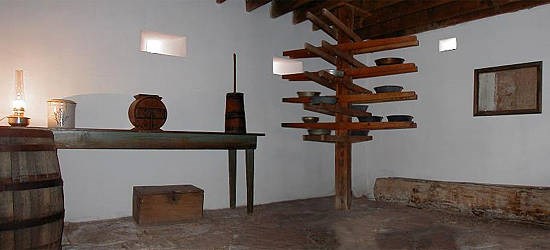|
Although it is called the "spring room," Pipe Spring actually bubbled out of the sandstone underneath the floor of the parlor. It was directed across the courtyard and emptied into the trough you see in the lower right of the photo below. From here the water exited the fort and fed the ponds. |
Because the spring water was covered for much of its short journey from the earth to the spring room, it remained quite cold as it ran through the open trough against the wall. This kept the temperature in the spring room between 48 and 50 degrees Fahrenheit year-round. The room was used for both cold storage and the production of butter.
| |

| ||
|
Each day, the ranchers would milk between 80 and 100 cows. Some of that milk would be brought into the spring room and placed in shallow pans on the cooling rack shown above. In the cool temperatures of the spring room the cream would rise in the pans and be skimmed off. The cream was then churned into butter. Several types of butter churns are shown on the long table in the photo above. |
Each day, the women and children would churn up to 40 pounds of butter; they would also produce 60-80 pounds of cheese. Some of the butter and cheese was produced for family use, but the majority of these dairy products were bound for St. George, Utah, to supply hundreds of men working on public roads and the St. George Temple and Tabernacle. | |
Last updated: April 16, 2020
